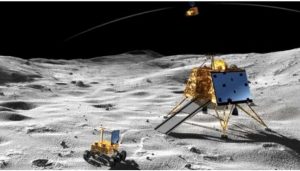OCTOBER 4, 2019

There is not a lot the United States or its space agency Nasa can do to help diagnose what went wrong with the Chadnrayaan-2 lander Vikram, the country’s secretary of commerce Wilbur Ross said Friday.
Ross said that Vikram’s communications system was internal to India and so, “I don’t think we [the US] can do much about it”.
Ross said this while speaking to India Today TV in Bengaluru, where he met with Indian Space Research Organisation chief K Sivan.
Isro lost contact with the Vikram lander when it attempted landing on the Moon on September 7. Contact was lost in the final stages of the landing attempt. Isro has been unable to re-establish contact with Vikram, which carried the six-wheeled lunar rover Pragyaan, since then.
Chances of re-establishing communications are next to none now as night has descended in the south polar region of the Moon where Vikram attempted landing. During night, temperatures in the region plunge to less than minus 200 degrees Celsius and Vikram, which does not have any heating apparatus onboard, is not likely to survive the cold.
Apart from Isro, the US space agency National Aeronautics and Space Administration has also been involved in the efforts to determine Vikram’s fate. Earlier last month, Nasa sent its Lunar Reconnaissance Orbiter to photograph Vikram’s landing site. While the LRO was able to image the landing site, it wasn’t able to spot Vikram as the photograph was taken during dusk when there are long shadows on the Moon.
‘CAN’T DO MUCH’
Speaking to India Today TV in Bengaluru, US secretary of commerce Wilbur Ross noted that Vikram’s communication system was internal to India. “I don’t think we [the US] can do much about it… To figure out the exact cause is hard.”
Ross also referred to an India Today Magazine report that examined what may have gone wrong with Vikram. The report, based on data and information gathered by India Today Magazine, suggested that Vikram may have performed a somersault during its lunar descent.
Because of this, Vikram’s reverse-thrust producing engines, which were meant to slow the lander down, briefly faced the sky and instead of slowing the craft down propelled it towards the lunar surface. Communication with Vikram was lost around the same time.
ORBITER
Meanwhile, the Chandrayaan-2 orbiter is safe in its orbit around the Moon and has begun performing experiments. On Thursday, Isro said the orbiter had managed to detect charged particles near the Moon.
These particles are a result of ‘solar wind’ (a stream of electron and protons) interacting with the Earth’s magnetic field, which extends behind our planet. When the Moon (and thus, the Chandrayaan-2 orbiter) is behind Earth, these charged particles interact with its surface, offering a chance to perform experiments.
Isro hopes to use the Chadrayaan-2 orbiter to detect the presence of several minerals on the Moon when these charged particles hit the lunar surface.
The Chandrayaan-2 orbiter will continue its mission for seven years. One of the most crucial missions it will perform will be estimating the quantity of iced water in the Moon’s south polar region.
As for as Vikram — the coming days when daylight returns to its landing site, should offer more clues on its fate.







































































































